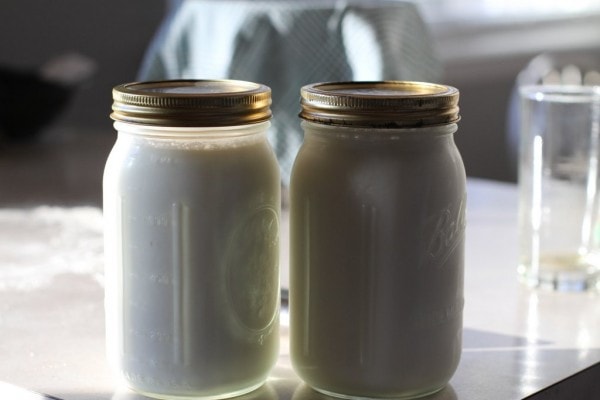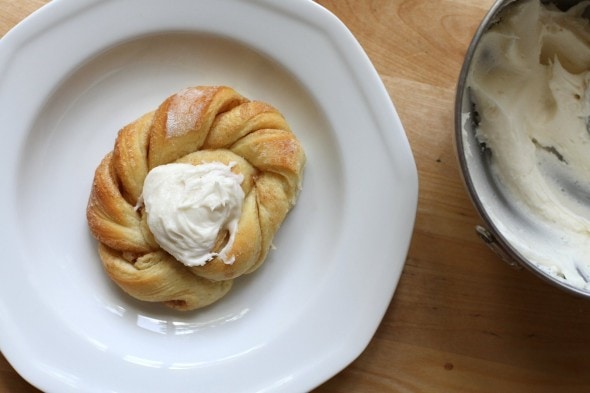Every other Monday, I answer a few of the questions that my readers send me. If you have a question you’d like me to answer in a future Q&A post, just leave me a comment here or email me (thefrugalgirl [at] gmail [dot] com) and put Q&A in the subject line. I look forward to hearing from you!
I wondered, on your yogurt recipe, would reduced for quick sale milk work for that? I often find milk reduced to $1.95 per gallon and thought that would be wonderful for the yogurt. I just wondered if the expiration date of the milk would still apply to yogurt or if the process changes that in any way.
Thanks,
Michelle
Though I’ve never tried it (Aldi never has quick sale milk!), I think that should work just fine. I’m not positive about the science behind it, but turning milk into yogurt seems to keep it fresh beyond its expiration date.
When I buy a gallon of milk and turn it into yogurt, that yogurt will keep for a month or so in the fridge, and I know that a month is past the expiration date of the milk.

So, it seems to me that using milk which is close to the expiration date should be no problem. It’s not like you’re using sour milk (I did some googling and people have had mixed results with that.)…it’s just milk that will soon be past its sell-by date.
And a sell-by date is different than a use-by date, so the reduced milk is probably still days from going sour.
I say go for it. And let us know how it works out.
(Here’s how to make yogurt at home. No machine required!)
I was wondering if you could PLEASE share your sweet roll recipe? That picture from June 20th when you used the 3 egg yolk looked amazing! Thank you!
-Amy
Sure thing! You can find my grandma’s sweet roll recipe right here, with both apricot and cinnamon variations.

You might also enjoy my overnight cinnamon twists or my overnight cinnamon rolls.
I’m refinishing my dining room table. I was going to stain it but then I saw your painted furniture so I’m not sure. Anyway, your step-by-step guide to painting wood furniture is great and makes me feel brave enough to paint (black)…maybe. Do you have similar guidance for staining wood furniture?
Thanks so much,
Connie
I actually haven’t done a whole lot in the way of staining, both because I’m kind of in love with the look of painted furniture and because staining requires more thorough prep work.
To stain an old piece, it really is best to take the old finish completely off so that you’re dealing with bare wood.
To paint an old piece, you just have to sand enough to smooth out the surface and remove the sheen.
So, painting = easier, just because the prep work is so much less demanding.
If your table has very simple lines, it might not be super hard to get the old finish off entirely, but if it’s at all ornate, it’ll be tough to get off all of the old stain.
I love the look of black dining room tables, so I say go for painting! It’ll be less work and will probably look fabulous.
One tip: I don’t normally apply a coat of polyurethane to my pieces, but for a dining room table, which will receive a lot of wear and tear, I’d do a coat or two of poly.
(P.S. I did try out some Cabot water-based stain last summer, and I use it on a mirror and a doll bunkbed. It was super easy to work with because it’s water based, and it produced a hard, durable finish. So, if you do go the staining route, I highly recommend this product.)
_________________________
Readers, as always, feel free to chime in with your own advice!
(And if any of you science-y types have thoughts about why yogurt-making extends the life of milk, go for it.)

Heather @ My Overflowing Cup
Monday 23rd of June 2014
In my experience, I have found that using older milk is just fine for yogurt, as long as it doesn't smell rancid. I say give it a try!
Gladys (The Pinay Mom)
Monday 23rd of June 2014
I'm looking forward for your sweet cinnamon roll bread recipe post soon!
Stephany
Monday 23rd of June 2014
Hi Everyone! My question is in regards to all of the delicious recipes for the Cinnamon/Sweet Rolls. I dont' have a stand mixer (actually, I had one but I gave it away becuase I never used it!) and am wondering what alternative method there is for mixing the bread dough. Can I just my regular hand held electric mixer in some way? Thanks.
WilliamB
Monday 23rd of June 2014
Cooks Illustrated recommends two handhelds for heavy mixing 1. Cuisinart Power Advantage 7-Speed Hand Mixer (winner), est $50 2. KitchenAid Professional 9-Speed Hand Mixer (runner up), est $70
Karen.
Monday 23rd of June 2014
My mom has a five-speed Kitchen Aid hand mixer that came with dough hooks. They look different than the stand mixer dough hook — more of a spiral shape. After 45 years of making bread by hand, she is in love with these dough hooks. The key (she says) is getting a mixer that is up to the task. Dough is hard on hand mixers.
Kristen
Monday 23rd of June 2014
Like Liz, I wouldn't use a hand mixer. Just mix the dough well by hand and then knead it a little longer than the recipe specifies.
Liz
Monday 23rd of June 2014
I used to have stand-mixer, but it took up too much space. Now I just mix all my doughs by hand. I use a spoon or spatula to get the dough started, and then started kneading by hand in the bowl. I would not recommend using a hand-mixer, as you're liable to break the machine against the stiffness of the dough!
Frances
Monday 23rd of June 2014
I don't know the detailed scientific description as to why yogurt keeps so long but I think the general ideal is "the good guys win".
Essentially, any food is a potential "home" for critters whether good or bad. When you make yogurt you are inoculating it with a high (relative to the naturally occurring critters) concentration of the bacteria you want in the milk. Then you incubate it so that these guys are happy and reproduce and essentially "fill up their home". This preserves the milk because the good bacteria out-compete the bad bacteria and mold preventing it from getting a foothold in your yogurt.
I find the idea of good bacteria fascinating - I hope I haven't grossed out the non bio-nerd readers!
Thanks for a wonderful blog,
Frances
Mairsydoats
Monday 23rd of June 2014
I believe this is exactly it. When the chemical structure changes from milk to yogurt, it becomes much more stable. The protiens that are potential food for the bad bacteria (that make milk sour) is already eaten by the good yogurt bacteria (which make it sour in a much happier way for our consumption).
Anne
Monday 23rd of June 2014
I bought extra milk last Friday since it was the expensive brand on sale, because the use by date was Sunday, and yesterday used half of it to make quick cheese with vinegar in the microwave.